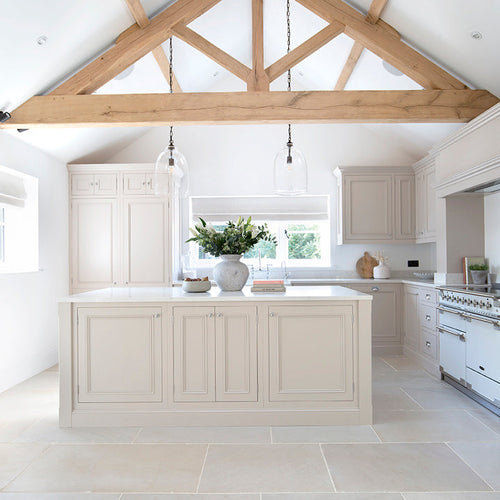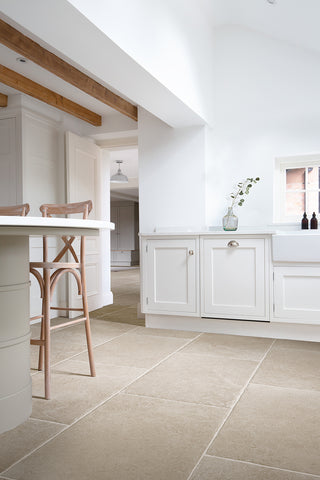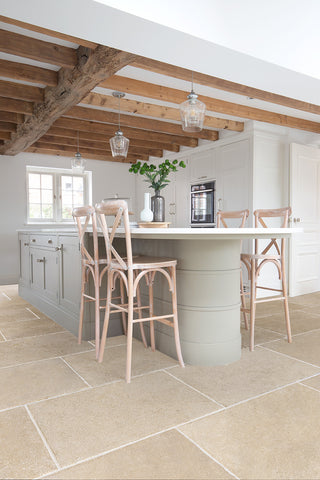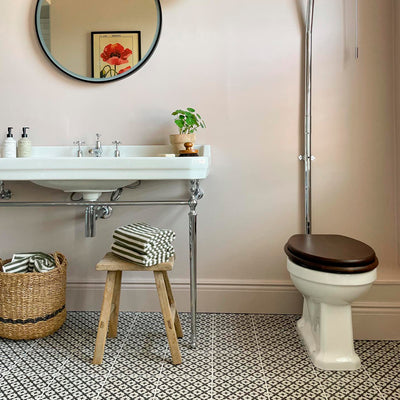When it comes to renovating, extending, or perhaps building an entirely new kitchen and finding kitchen floor tiles, there are so many decisions to make and things to consider. With 30 years of experience and expertise in the industry, our passion for beautiful stone kitchen flooring remains at the core of who we are, so we thought we'd share 10 kitchen flooring trends forecasted for 2025 that are set to stay.
Shop Kitchen Floor Tile Ideas
1. Large Flagstone Flooring Trend
The first trend we are seeing for 2025 is the large flagstone tiles look. For centuries, estates and country homes have used flagstone flooring (natural stone slabs), thanks to their hardwearing characteristics and classic appearance that have stood the test of time. Across the interiors industry, we have seen more wanting to create this timeless look in their kitchens by choosing large format flagstones. Most commonly, the ‘free length’ or ‘random length’ tile size is opted for, by which the widths are fixed (usually 500mm or 600mm) and then lengths are a random selection ranging upwards to 1000mm. This free length flagstone has the ability to work in all sized kitchens and gives maximum focus on the beauty of each tile. Seen below is the Versailles Limestone 600xFL(700-1000mm) and Tuscany Seasoned Limestone 600xFL(700-1000mm) in this random length format.
2. Dijon Limestone Kitchen Tiles
Dijon limestone tiles are a timeless classic that we have been importing for nearly 30 years. The longevity and beauty of Dijon limestone makes it an enduring trend when it comes to kitchen flooring. Dijon is a neutral toned limestone tile that complements an array of colour schemes with its soft beige and light grey hues. The minerals, fossils and calcite veining evident in this limestone tile offer a forgiving choice for both interior and exterior applications. Dijon limestone is also available in a variety of finishes and tile sizes - our most popular finishes being ‘tumbled’, ‘brushed’ and ‘seasoned’. Read more about the different natural stone finishes here.
|
|
|
|
 |
3. Buff Kitchen Tiles
Offering the ultimate neutral with soft pale wash tones and unique tones, buff sandston kitchen tiles will be a trend for 2025 in flooring. Sandstone, like limestone, is a hardwearing and practical option ideal for kitchen tiles, the texture also provides grip underfoot. Buff coloured tiles complement the much-loved modern country look and also work with an array of different paint colours. The Abbey sandstone flooring is suitable for both indoors and outdoors and capture this on-trend buff, neutral palette perfectly.
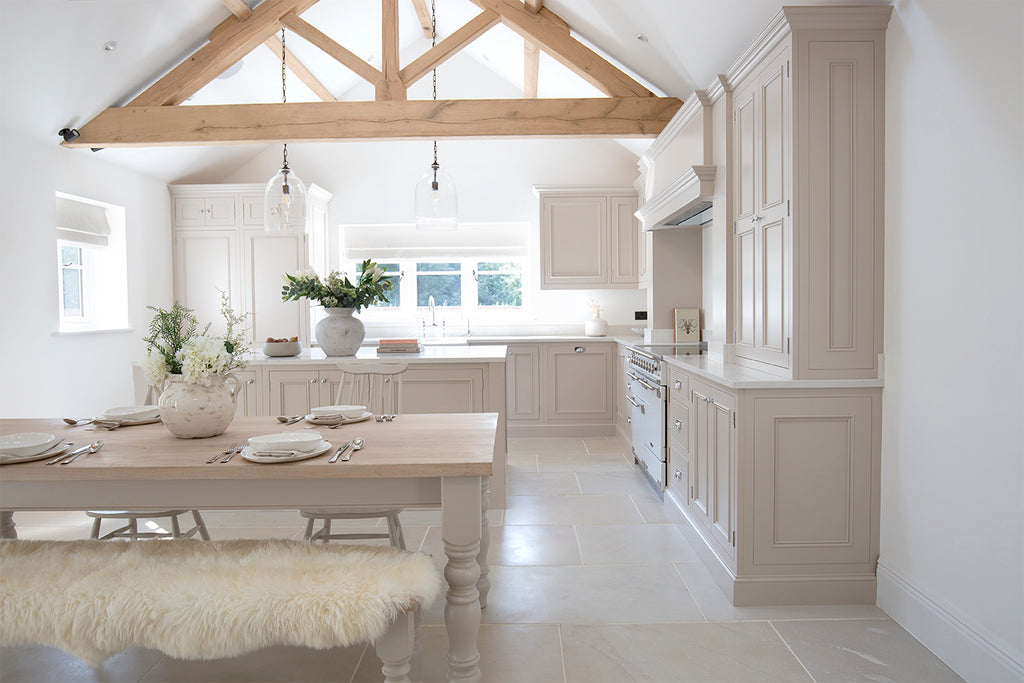 |
4. Textured Limestone Kitchen Tiles
2025 is all about texture in the home and textured limestone kitchen tiles are high on the list for our top 10 kitchen flooring trends. Whether it’s classic grey limestone tiles like the Clermont Gris® aged-tumbled or a honey beige such as our Sorrento® aged-tumbled, both provide rich variation from tile to tile with rustic and textured finishes for that true farmhouse kitchen look.
 |
Clermont Gris® Aged Tumbled limestone is a classic limestone tile, featuring beautiful tonal variations of soft greys. The varying grey hues within this stone blend effortlessly, with a slight warmth and a timeless charm. This grey neutral toned natural stone lends itself to both modern and country projects alike, whilst the fossilised details evident, make it a forgiving choice for both interior and exterior applications.
 |
Sorrento® Aged Tumbled limestone has varying beige and honey hues, blending effortlessly with cooler undertones in soft fossil details. This beige neutral toned natural stone complements an array of kitchen and interior schemes, whilst its aged tumbled finish and natural fossil appearances, offer unique texture and detail within each limestone tile creating an aged, lived in appearance
Stone Look Kitchen Floor Tiles
5. Tumbled Effect Porcelain Trend
There is a rising popularity in stone look kitchen floor tiles, thanks to their low maintenance and realistic nature. With an increasing range of shades and styles available, tumbled effect porcelain will be a continued trend in 2025 for kitchen floor tiles. Together with the character and variation from tile to tile, this soft tumbling effect lends itself beautifully to rustic, and modern country-style kitchens. Many of the tumbled edge porcelains out there are hard to distinguish from a natural limestone! A few of our favourites include the Alnwick Ivory, Hambleton Ivory and Provence Grigio stone effect tiles.
 |
|
6. Beige Kitchen Flooring Tiles
It's no secret that beige appears to be the new grey, offering warm and neutral hues that work will all interior schemes. Beige tiles are sticking around in 2025, with beige stone effect porcelain offering a variety of prints and tones. For those wanting to achieve the perfect country kitchen, look no further than our Hambleton Beige stone effect porcelain and Montpellier Sable stone effect porcelain with their soft beige and honey hues and soft tumbled effect edges.
7. Large Format Porcelain
With state-of-the-art machinery advancements, large format porcelain tiles are becoming an on-trend and popular tile size to choose. Stone effect porcelain tiles are most commonly in 900x600 tile sizes, but recently 1200x600 and 1000x1000 super-size porcelain tiles have become available and really do make the perfect addition for an impactful kitchen floor space. A large format tile works in open plan kitchens and helps to minimise grout lines and maximise the focus on each tile. Another consideration is whether you lay rectangual tiles width or length ways from the point you stand (from a doorway or viewpoint). For narrow spaces, width ways will make the space appear wider. For shorter spaces, length ways will make a kitchen appear longer …your eyes will naturally always follow the line of the tiles. Photographed below show two examples of porcelains, Melford Ivory in 1200x600 and Arlet Cloud in 1000x1000 - showing how a larger tile can work in small, as well as open plan kitchens.
 |
 |
Wood Effect Kitchen Flooring
8. Oak Wood-look Kitchen Tiles
Wood effect porcelain flooring is a more practical choice to solid wood floor and the prints and tones available certainly do mimic the look of real wood! Oak wood-look kitchen tiles offer an authenticity and warmth just as real oak does, working beautifully with oak beams – an ever-popular feature to have whether it be in a new build or an original element of character properties. The Henbury Antique Oak wood porcelain ticks all the boxes for a neutral oak wood-look porcelain. Wood effect porcelain, unlike real wood, is also suitable for underfloor heating. Underfloor heating is an increasingly popular asset to have in the home - providing warmth from the floor up.

9. Herringbone Tile Trends
One kitchen floor trend for 2025 is the popular herringbone tile. Whether it is a smaller parquet wood tile or a larger wood effect tile, these alternative laying patterns add something a little different to a kitchen. The key distinction between herringbone and chevron is that herringbone tiles meet at a 90-degree angle for an effective zigzag look, whereas the chevron format meet neatly together at one point. Traditionally, parquet kitchen flooring is laid in a herringbone format. Below is the Falmouth Sandy Oak wood look porcelain tile and Eaton Oak in a herringbone pattern.
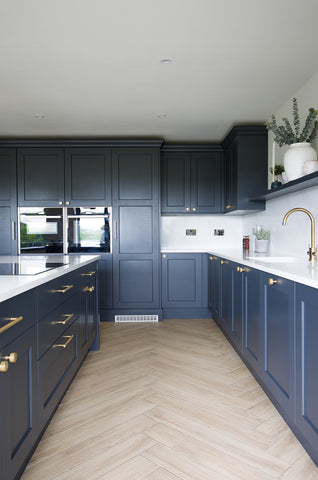
|

|
10. Parquet Wood-look Tiles
If you’re wishing to create a classic basketweave effect in your kitchen then the Alderton parquet wood effect range is for you. The soft neutral tones in wood effect tiles help to create a calm and inviting kitchen space and the parquet pattern offers a timeless and elegant feel. The intricate texture and pattern of this parquet wood effect tile also provides a forgiving surface for everyday busy homes, pictured below in the Birch and Walnut shades.
|
|
|
Frequently asked questions
1. What tile size should I choose for my kitchen floor?
The size tile you go for is personal preference – there is no right or wrong! However, over the years we have developed a keen eye on what sizes and formats work best for all shapes and styles of kitchens. All our natural stone and porcelain tiles are mostly stocked in large format sizes. Natural stone tends to be 500mm width by free-length (random lengths) or 600mm width by free-length (random lengths). Stone effect porcelain is most commonly 1200x600, 900x600 or 800x800 in size. A large format tile works in open plan kitchens and helps to minimise grout lines and maximise the focus on the tile. Alternatively, porcelain is also available in smaller 600x300 or 600x600 for smaller spaces such as a galley kitchen - for natural stone we would advise a 600x400 tile size.
2. What is the difference to natural stone and porcelain?
Natural stone, as it says in the name, is an entirely natural product that is formed over millions of years - whether it be a limestone, sandstone, or marble. The characteristics, colours and finishes between natural stone vary which provides a wide variety of choice for the flooring market.
A porcelain tile is a man-made product made of clay that is fired to an extremely high temperature (upwards of 1200 c). With state-of-the-art printing on porcelain tiles significantly advancing, porcelain offers many realistic stone look and wood look possibilities.
Both natural stone and porcelain are ever-popular options for kitchen floors thanks to their dense and hardwearing qualities. Natural stone does need sealing but only every 3-5 years and is low maintenance, whilst porcelain does not require sealing and is pretty much maintenance free.
3. How do I look after my kitchen floor?
Kitchen floor tiles will probably see the most footfall and use than any other room in the house! With this in mind, porcelain and natural stone are very practical options with just a few key steps needed to look after your stone floor and keep it looking its best for years to come.
Natural stone needs sealing when installing which acts as a protective barrier against stains, vacuuming with a brush attachment is recommended and spot cleaning any spillages promptly. Any harsh, acidic cleaners need to be avoided with natural stone – look for pH neutral cleaners and cleaners that say, ‘suitable for natural stone’. If you do have any stubborn stains on the tiles, there are products available to help remove these. Keeping mopping to a minimum will help the sealant to last longer and avoid mopping excess dirt into the grout.
When it comes to porcelain you do not need to seal the tiles, and the surface is not as sensitive to spillages or cleaners. We still advise brushing or vacuuming for day-to-day maintenance, but in addition you can also use a steam mop.
One big benefit of looking after a natural stone or porcelain kitchen floor is that not only are they hardwearing materials, but also very forgiving – because of the natural variation, details or prints found in the tiles that disguise everyday dust and dirt.

So, there we have it - our top 10 kitchen flooring trends for 2025 that hopefully inspire and help you on the journey to finding your perfect stone kitchen floor. There are plenty of different floor options currently trending that will offer you a beautiful, but enduring floor, that will stand the test of time.
If you are wanting to gather further kitchen flooring ideas, you can do this by ordering your free tile samples or by visiting one of our UK tile stores.
